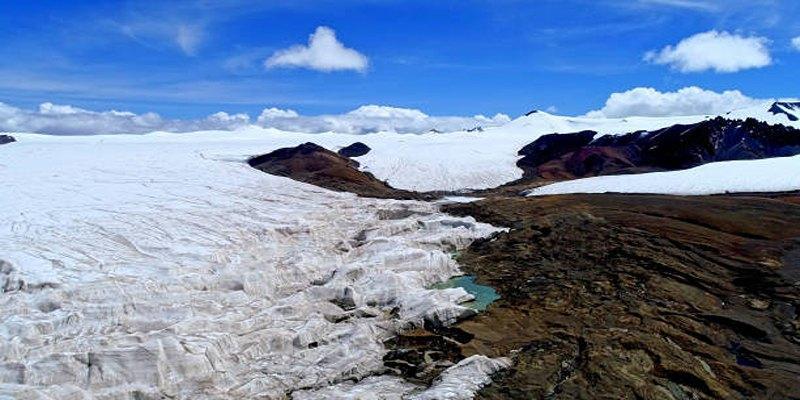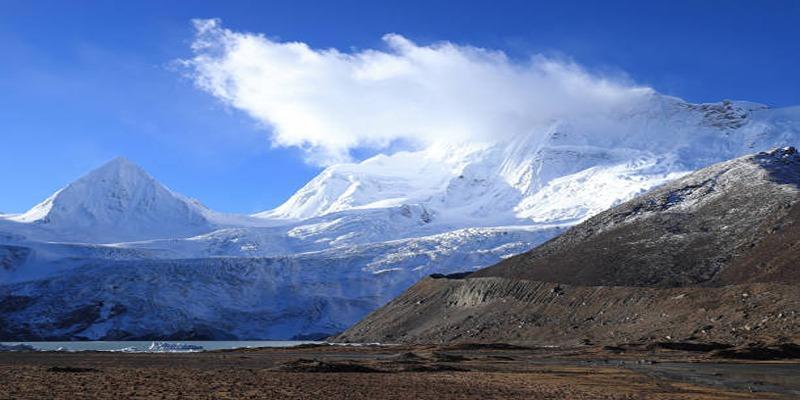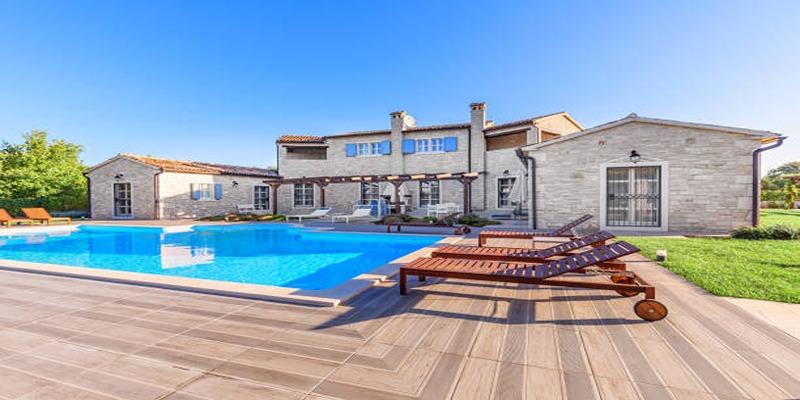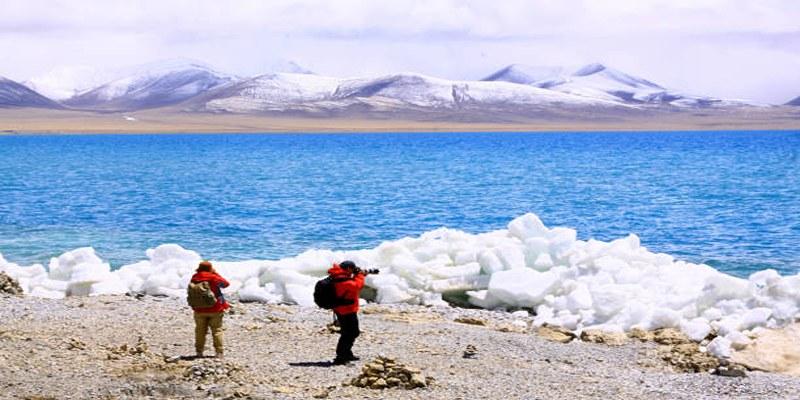The legendary Roof of the World known as Tibet is the land of the most magnificent glaciers on earth. These frosty wonders make the landscapes, nourish rivers, and spark spiritual diversion. The glaciers in Tibet range along the dazzling falls of ice, down around the valleys and oceans of turquoise that immediately remind visitors of the magnificence of nature and its impeccable beauty.
Yamdrok Glacier: A Mirror of Serenity by the Sacred Lake

Located next to one of the most sacred waters in Tibet, the Yamdrok Lake, the Yamdrok Glacier impresses the travellers by its fragile beauty. The glacier when pouring out of the surrounding hostels shows a polishing contrast with all that is turquoise on the lake surface, making an almost unreal vision. Coupled with the harmony of rock and water, it is this that harmonizes the Yamdrok Glacier to make it a site where spirituality and nature merge in perfect harmony.
The sacredness of the lake is reflected in the glacier since both are strongly linked to the worship of Tibetans. A large number of pilgrims would travel to the region and visit the region because of peaceful environment and the divine presence that emanates throughout the area. Anyone who has seen the glacier in the light of the morning, when the prayer flags are gently floating around, has seen played out in fact the spiritual being of Tibet.
To a traveler, the Yamdrok Glacier can also be accessed and experienced with exceeding comfort and glory. Lhasa to Yamdrok Lake is an easy ride that can only be completed within a couple of hours, which means that it is one of the more manageable glacials in the eyes of the tourist who is not very much acquainted with such high-altitude locations.
Walking Light tours also supply possibilities to test the surroundings both by freezing a few ice ridges on cam and enjoying the tranquility merely by sitting somewhere and appreciating the calm. Although Yamdrok is not always considered to be the biggest glacier in Tibet, its suggestive scenery is such that all visitors remember it well.
Midui Glacier: The Symphony of Ice, Forests, and Lakes
The Midui Glacier in Nyingchi, located in a fertile region, is even hailed as one of the most beautiful glaciers in China. However, while many glacier landscapes feel lifeless—with only rocks and ice as their dominant features—Midui boasts a rare diversity of ecosystems. In this case modern forests cover the foothills, green lakes reflect the sky and villages beautifully stand on the trip border of the ice deserts. What ensues is the creation of a scene in which each look unveils an extra detail of fascination.
The extraordinary aspect of Midui is the availability of the beauty there. The glacier also extends into valleys at relatively lower altitudes, thus making exploration easier for travelers compared to high mountain trekking—which requires strenuous physical effort.
Approaching, one will think it is some sort of frozen waterfall falling down off the high peaks with its jagged crevasses and crystal surfaces reflecting the light in myriads of brilliance. Besides the visual opulence, there is also the cultural richness of Midui. The standard Tibetan architecture and hospitality that Tibetan villages showcase around the glacier allows the visitors to combine both their natural and cultural inquiry.
It is an image of a perfect harmony of people and their life against nature as the massive wall of ice in the background and the crowd of locals assimilating agencies with fresh air as part of their daily work, leave an unforgettable picture of agricultural work. Midui Glacier is not just a place, it is an active canvas, color, texture, and traditions merge in the amazing masterpiece.
Karola Glacier: Tibet’s Icy Stage on the Roof of the World
The Karola Glaciere which acts as a guardian on the way between Lhasa and Gyantsse is perhaps the most fascinating glacial scene in Tibet. Acclimating more than half of 5,000 above the sea level, it drains off of Mount Nyenchen Khangsar, the white walls taking the pre-eminent position in the horizon. The glacier is near to the road to the extent visitors may have the impression of reaching and feel the shinning ice.
Karola Glacier has been a substantial attraction site to explorers over time not only as it can readily be accessed by pedestrians, but also owing to its absolute magnitude. Karola is unable to make the visitor engage in cumbersome cations as the glaciers further out are, so its very cold slopes are met almost immediately, revealing the barren deems near Karola.
On the bright sunny days the glacier is white as shiny as ever, and in the shade it exposes patches of blue ice, that promises of how very deep they are. However, Karola Glacier is more of a scene, it is bathed in spiritual meaning. Prayer flags wave at its feet in a kind of reflection of the Tibetan admiration of mountains and glaciers as divine protectors of the earth.
The location is heaven to the photographers, and provides them with one of the most recognizable scenery in Tibet. To a visitor, it reminds of the amazing opportunity of nature and faith that existed in the region and lets to imagine that a visit to a roadside rest can be like entering a theater of faith and ice.
Rongbuk Glacier: The Icy Gateway to Everest’s North Face

For those who dream of standing in the shadow of the world’s highest mountain, the Rongbuk Glacier is an unmissable destination. Situated near the northern base of Mount Everest, this glacier is one of the largest in the region and plays a critical role in shaping the landscapes of the Himalayas. Its immense ice flows and deep crevasses create a dramatic approach to Everest, making it both awe-inspiring and humbling.
The Rongbuk Glacier is more than a frozen wonder—it is a vital lifeline, feeding rivers that flow across Tibet and into surrounding regions. Its surface, marked by jagged ridges and ice towers, reflects the raw, untamed forces of nature. For trekkers journeying to Everest Base Camp, the glacier is both a challenge and a reward, offering a firsthand glimpse into the power of glacial landscapes.
Adding to the glacier’s allure is its proximity to Rongbuk Monastery, the highest monastery in the world. Here, spiritual devotion meets natural majesty. Monks chant against the backdrop of Everest’s north face, creating a scene that encapsulates Tibet’s unique blend of faith and wilderness. Standing at Rongbuk, with the glacier stretching before you and Everest looming above, is an experience that words can hardly capture. It is the ultimate reminder of humanity’s smallness in the face of nature’s grandeur.
Conclusion
The glaciers of Tibet are hardly, therefore, simply the natural marvels, but living monuments to the strength, beauty, and spirituality of Himalayas. Every of the glaciers is narrating: Yamdrok, its peaceful harmony with its lore lake, Midui, its harmony of ice and wood, Karola with its assumption on its perch, and the role of Rongbuk, the gateway in ice on its way to Everest. Two things, they create a resilience narrative, a divine narrative, and awe narrative.












